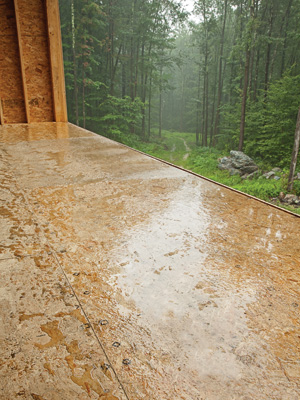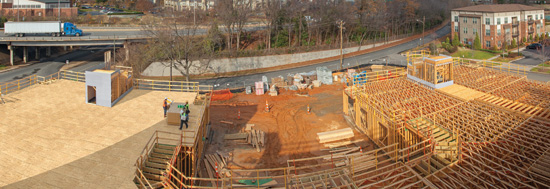Subfloor as a Hidden Asset

Moisture-resistant resins play a part in the effectiveness of high-performance subfloors.
Photo courtesy of Huber Engineered Woods © 2014
Moisture Resistance
A common cause of flooring problems is excessive moisture content in the subfloor at the time the finish floor is being installed. Possible consequences include swollen panel edges and degradation of the panels' fastener holding ability. A typical hardwood floor that absorbs too much of this moisture can expand and buckle.
There is a difference in plywood and OSB moisture content regarding applying finished flooring. For instance, plywood tends to buckle, warp, and delaminate when exposed to excess moisture, while OSB swells more around the perimeter. Manufacturers have tried to address perimeter swelling with edge seals, but site-cut edges limit that protection. Joe Pusateri of Elite Homes in Louisville, Kentucky, feels that moisture-related issues can be sufficiently troublesome to scheduling. “In the past, we had to add a day into our building scheduling to repair the damaged plywood spots caused by the moisture-related issues,” he says. Once they began using high-performance products they were able to remove that step in their building process, which saved them time in the long-run.
Moisture problems can be complicated by a high relative humidity or exposure to rain during construction. On a jobsite, rain and foul weather are a reality, with the average jobsite receiving rain three times during construction. In some areas of the country, snow and ice are a certainty as well and can expose projects to even more moisture. Better moisture resistance helps reduce the rate of water absorption into the panel, even under harsh weather conditions. Brice Craig, of Craig Builders in Charlottesville, Virginia, says one of the things he finds most noticeable about high-performance subflooring is what happens on the jobsite after a rain storm. “I know I'm not going to have any problems with the product because you get to the site and just see puddles of water sitting on top of subflooring,” he says.
Chance Miller, whose family has been building homes in the New Orleans area for four generations, concurs. “If I'm using regular plywood or OSB flooring and it rains before the roof is installed, those panels absorb that water, and I no longer have a truly flush flooring system,” says Miller. He compares that to high-performance flooring that has water-resistant sealing on all sides and offers a warranty just in case and it becomes a no-brainer.
Stiffness
When comparing floor systems with the same structural framing, using a stiffer subfloor panel provides a more solid-feeling floor system with a greatly reduced chance of squeaky wood planks and cracked ceramic tiles. Stiffness is a function of the panel thickness and type, as well as of the spacing between underlying joists or trusses. High-performance panels are designed to enable stiffer floors which, in turn, make for more satisfied homeowners. It is important to note that because of their higher strength and stiffness values along both axes (parallel and perpendicular), high-performance panels offer added insurance to designers regardless of the layout. This is particularly important in case a panel gets incorrectly installed parallel with the joists instead of perpendicular to the joists.

High-performance subfloor panels ensure maximum strength for complex floor support layouts, helping to guard against mistakes by installers.
Photo courtesy of Huber Engineered Woods © 2014









